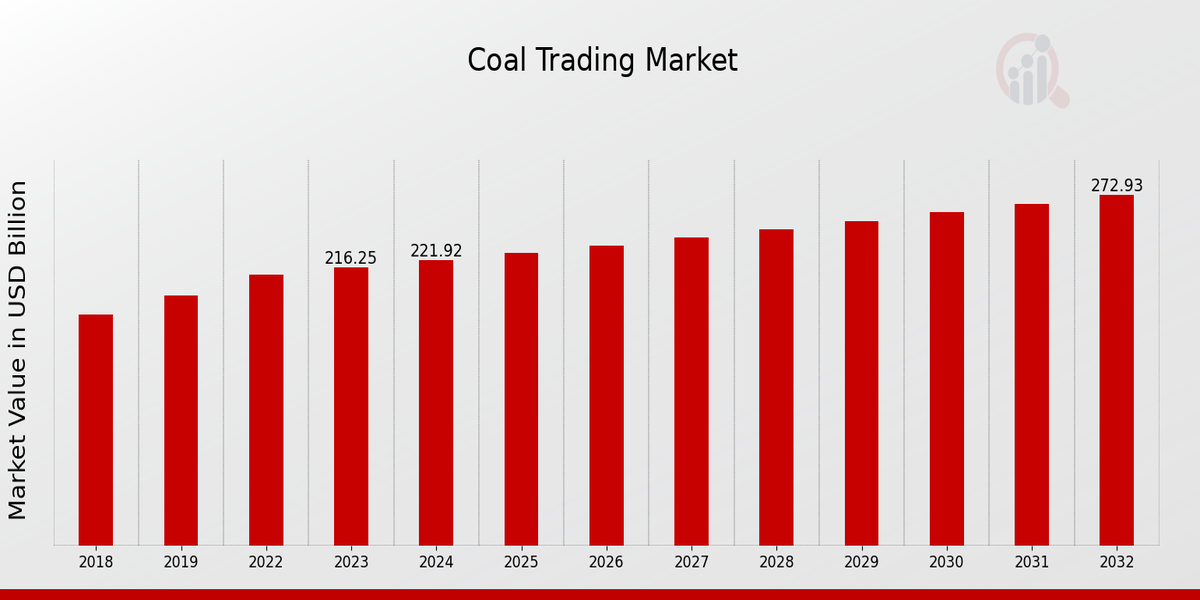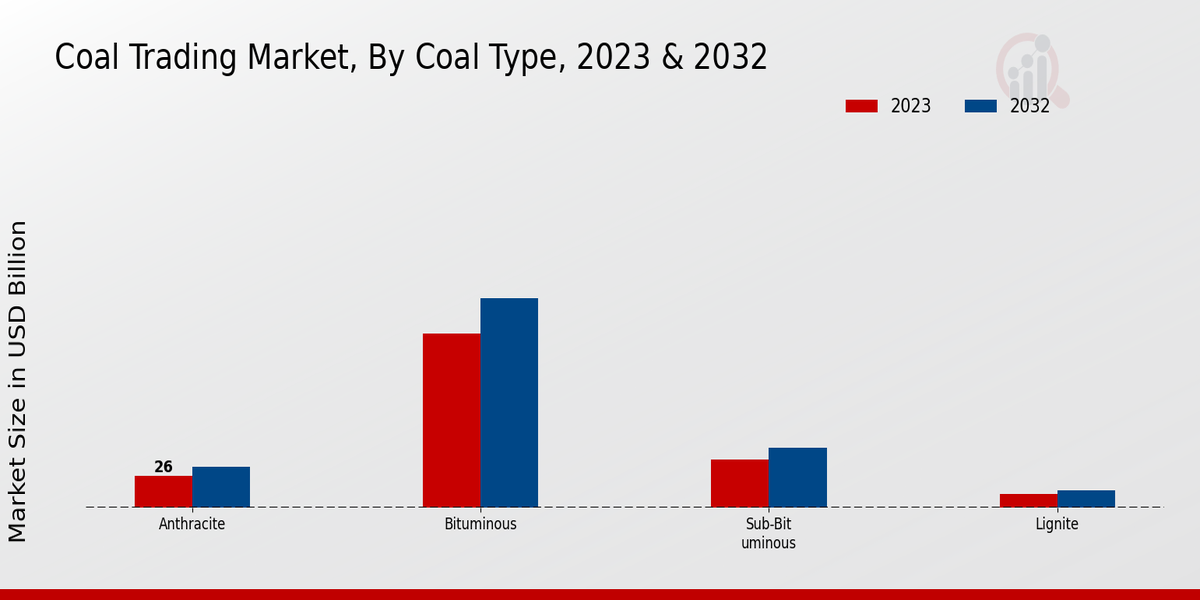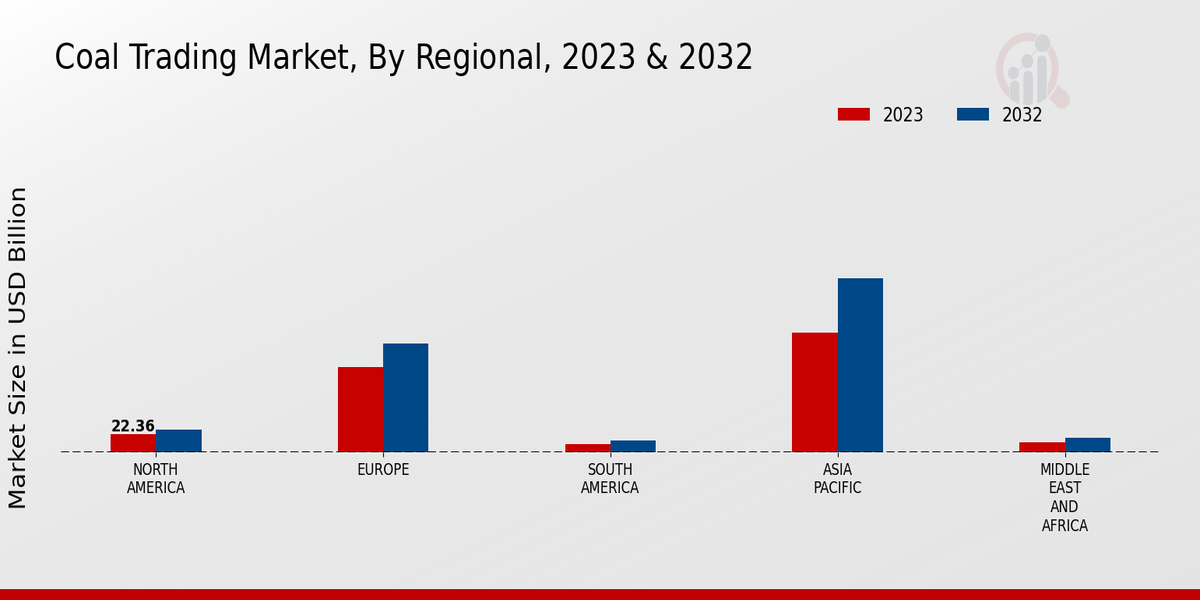Global Coal Trading Market Overview:
As per MRFR analysis, the Coal Trading Market Size was estimated at 227.74 (USD Billion) in 2024. The Coal Trading Market Industry is expected to grow from 233.72 (USD Billion) in 2025 to 295.02 (USD Billion) till 2034, at a CAGR (growth rate) is expected to be around 2.62% during the forecast period (2025 - 2034).
Key Coal Trading Market Trends Highlighted
Growing energy demand, particularly in developing economies, is fueling the coal trading market. Coal remains a significant source of electricity generation, with countries like China and India relying heavily on it due to its affordability and availability. Market trends indicate an increasing shift towards cleaner coal technologies, such as ultra-supercritical and integrated gasification combined cycle (IGCC) plants, to reduce emissions. Additionally, the demand for higher-quality coal with lower ash content is increasing due to tighter environmental regulations and the need for efficient combustion.
Opportunities exist in the exploration of new coal reserves, particularly in emerging markets, to meet growing demand. Furthermore, advancements in coal transportation and logistics infrastructure, such as the development of specialized coal ports and rail networks, are crucial for efficient and cost-effective trade.
Recent trends include the emergence of large-scale coal trading hubs, providing greater transparency and liquidity to the market. Additionally, the growing use of coal futures contracts and other financial instruments enables market participants to manage price risks and volatility.
 Source: Primary Research, Secondary Research, MRFR Database and Analyst Review
Coal Trading Market Drivers
Growing Demand for Energy
Source: Primary Research, Secondary Research, MRFR Database and Analyst Review
Coal Trading Market Drivers
Growing Demand for Energy
The coal trading market is primarily driven by the rising demand for energy, particularly in developing countries. Coal remains a significant source of electricity generation and industrial fuel, accounting for a substantial share of the energy mix. The increasing population and urbanization in these countries have led to a surge in energy consumption, driving the demand for coal imports. Additionally, the growing industrialization and economic development in emerging markets have further contributed to the increased demand for coal as a cost-effective energy source.
Government Policies and Regulations
Government policies and regulations play a crucial role in shaping the coal trading market. Governments worldwide are implementing various policies and regulations to address environmental concerns and promote sustainable energy practices. These policies include emission reduction targets, carbon pricing mechanisms, and renewable energy subsidies. Such regulations can influence the demand and supply dynamics of the coal trading market, affecting the market size and growth prospects.
Technological Advancements
Technological advancements in the coal industry have also influenced the coal trading market. Innovations in mining techniques, such as automated mining systems and improved safety measures, have led to increased coal production efficiency. Additionally, advancements in coal transportation and logistics, such as the development of specialized coal terminals and vessels, have facilitated the efficient and cost-effective movement of coal across borders, contributing to the growth of the coal trading market.
Coal Trading Market Segment Insights:
Coal Trading Market Coal Type Insights
The Coal Type segment of the Coal Trading Market is primarily classified into Anthracite, Bituminous, Sub-bituminous, and Lignite. Each type exhibits distinct characteristics and applications, contributing to the overall market dynamics. Anthracite, the highest-quality coal, is characterized by its high carbon content and low impurities. It is primarily utilized in residential heating and industrial processes, commanding a premium price due to its exceptional heating value. In 2023, the Anthracite segment held a market share of around 12%, valued at approximately USD 26 billion.
Bituminous coal, the most widely traded coal type globally, is known for its versatility and combustion efficiency. It is extensively used in power generation, industrial boilers, and steel manufacturing. The Bituminous segment accounted for a substantial 65% of the Coal Trading Market revenue in 2023, estimated at USD 140 billion. Sub-bituminous coal, with its lower energy content compared to Bituminous, finds applications in power plants and industrial settings. Its abundance and relatively lower cost contribute to its growing adoption.
In 2023, the Sub-bituminous segment captured around 18% of the market, valued at USD 39 billion. Lignite, the lowest-grade coal type, is primarily used for power generation in regions with limited access to higher-quality coal. Despite its low energy density and high moisture content, Lignite remains a significant player in the Coal Trading Market, particularly in areas with abundant domestic reserves. In 2023, the Lignite segment held a market share of approximately 5%, valued at USD 11 billion. The Coal Trading Market is expected to witness steady growth in the coming years, driven by increasing demand from developing economies and the expansion of coal-fired power plants. The market segmentation based on Coal Type provides insights into the specific dynamics and growth potential of each coal type, enabling stakeholders to make informed decisions and capitalize on emerging opportunities.
 Source: Primary Research, Secondary Research, MRFR Database and Analyst Review
Coal Trading Market Application Insights
Source: Primary Research, Secondary Research, MRFR Database and Analyst Review
Coal Trading Market Application Insights
Coal is primarily used for power generation, industrial processes, and residential heating. The power generation segment dominated the market in 2023, accounting for over 60% of the Coal Trading Market revenue. The industrial use segment is anticipated to grow at a steady pace, driven by increasing demand from industries such as cement, steel, and chemicals. The residential heating segment is expected to witness moderate growth, primarily in developing countries. The growth in the residential heating segment is influenced by factors such as increasing population, urbanization, and rising disposable income.
Coal Trading Market End-User Industry Insights
The End-User Industry segment of the Coal Trading Market holds significant importance, accounting for a substantial portion of the market revenue. Among the key end-user industries, Utilities represent the largest segment, consuming a significant share of coal for power generation. This segment is expected to maintain its dominance throughout the forecast period, driven by the growing demand for electricity. The Cement industry is another major consumer of coal, utilizing it as a fuel source for cement production. The growth of the construction industry, particularly in developing regions, is anticipated to fuel the demand for cement, thereby driving the consumption of coal in this sector.
The Steel industry also relies heavily on coal as a reducing agent in the production of iron and steel. The increasing demand for steel in various industries, such as construction, automotive, and manufacturing, is expected to positively impact the consumption of coal in this segment. The Chemicals industry utilizes coal as a feedstock for the production of various chemicals, including fertilizers, plastics, and pharmaceuticals. The growing demand for chemicals, coupled with the advantages of coal as a cost-effective feedstock, is expected to drive the consumption of coal in this industry. Overall, the End-User Industry segment plays a crucial role in shaping the Coal Trading Market. The growth prospects of these industries, coupled with the increasing demand for coal as a fuel and feedstock, are anticipated to drive the expansion of the Coal Trading Market in the coming years.
Coal Trading Market Transportation Mode Insights
The transportation mode segment plays a critical role in the Coal Trading Market, shaping the movement of coal from production sites to end-users. Among the dominant transportation modes, rail remains a preferred choice due to its cost-effectiveness and ability to handle large volumes. In 2023, the rail segment accounted for approximately 52% of the Coal Trading Market revenue, valued at USD 112.5 billion. The segment is expected to maintain its dominance, reaching a projected valuation of USD 140.6 billion by 2032, exhibiting a steady CAGR of 2.4%.
Ship transportation is another significant mode, particularly for long-distance shipments. The ship segment held a market share of around 35% in 2023, corresponding to a revenue of USD 75.6 billion. Driven by increasing international coal trade, this segment is anticipated to grow at a CAGR of 2.7%, reaching an estimated valuation of USD 98.4 billion by 2032. Truck transportation, while accounting for a smaller market share compared to rail and ship, remains crucial for short-distance haulage and last-mile delivery. In 2023, the truck segment held a share of approximately 13% of the Coal Trading Market revenue, valued at USD 28.1 billion. This segment is projected to experience a steady growth rate, reaching a projected valuation of USD 34 billion by 2032, growing at a CAGR of 2.1%.
Coal Trading Market Form Insights
The Coal Trading Market is segmented by form into Run-of-Mine (ROM) Coal, Prepared Coal, and Coke. Run-of-Mine (ROM) Coal is the raw coal extracted from mines without any processing or cleaning. It contains impurities and has a lower market value compared to processed coal. Prepared Coal has undergone processing to remove impurities and improve its quality. It is classified into various grades based on size, moisture content, and ash content. Prepared coal commands a higher price in the market due to its consistent quality and suitability for various applications.
Coke is a solid fuel produced by heating coal in the absence of oxygen. It is primarily used in blast furnaces for steel production and has a relatively high market value due to its high carbon content and low impurities. The Coal Trading Market revenue for Prepared Coal is expected to grow at a CAGR of 2.1% from 2024 to 2032, reaching a valuation of USD 136.5 billion by 2032. This growth is attributed to the increasing demand for high-quality coal in power generation and industrial applications. The Prepared Coal segment holds a significant share in the Coal Trading Market due to its widespread use in various industries. It is preferred for its consistent quality, ease of handling, and higher energy content. Prepared coal is traded globally to meet the demand of power plants, steel mills, and other industrial consumers.
Coal Trading Market Regional Insights
The regional Coal Trading Market overview includes North America, Europe, APAC, South America, and MEA. The APAC region is expected to hold the largest share of the Coal Trading Market by 2024. The region is home to some of the world's largest coal producers and consumers, such as China and India. Europe is expected to be the second-largest market for coal trading, followed by North America. South America and MEA are expected to see significant growth in the coal trading market in the coming years. The Coal Trading Market was valued at 216.25 Billion USD in 2023 and is projected to reach 273 Billion USD by 2032, exhibiting a CAGR of 2.62% during the forecast period.
 Source: Primary Research, Secondary Research, MRFR Database and Analyst Review
Coal Trading Market Key Players And Competitive Insights:
Source: Primary Research, Secondary Research, MRFR Database and Analyst Review
Coal Trading Market Key Players And Competitive Insights:
Major players in the Coal Trading Market industry are constantly focusing on the development of innovative technologies and strategies to gain a competitive edge in the market. Leading Coal Trading Market players are investing heavily in research and development to improve the efficiency and sustainability of their operations. They are also forming strategic partnerships and collaborations with other companies to enhance their capabilities and expand their market reach. The Coal Trading Market development is driven by the increasing demand for coal as a source of energy in developing countries, coupled with growing concerns about climate change and the need for sustainable energy solutions. The Coal Trading Market Competitive Landscape is expected to remain competitive in the coming years, with key players focusing on expanding their market share and increasing their profitability.
Among the leading companies in the Coal Trading Market, Glencore holds a significant market share and has a presence. The company has a diversified portfolio of coal assets, including mines, processing facilities, and distribution networks. Glencore is also involved in the trading of other commodities, such as oil, gas, and metals. Another leading player in the Coal Trading Market is BHP Billiton. The company has a strong presence in the Australian coal market and is also a major exporter of other countries in the Asia-Pacific region. BHP Billiton is focused on the sustainable development of its coal operations and is investing in technologies to reduce its environmental impact.
A key competitor in the Coal Trading Market is Peabody Energy. The company is one of the largest coal producers in the United States and has a presence. Peabody Energy is focused on the production and sale of thermal coal for use in power generation. The company is also investing in the development of clean coal technologies and is committed to reducing its environmental footprint. Other notable players in the Coal Trading Market include Anglo American, Xstrata, and Rio Tinto. These companies are actively involved in the mining, processing, and trading of coal, and have a presence in various regions around the world.
Key Companies in the Coal Trading Market Include:
- Shell
- BP
- Peabody Energy
- Glencore
- Anglo American
- Vitol
- Mercuria Energy Group
- TotalEnergies
- Rio Tinto
- Vale
- Glencore International
- Gunvor Group
- Cargill
- Trafigura
- BHP Billiton
Coal Trading Market Industry Developments
The coal trading market is projected to witness steady growth over the coming years, driven by increasing demand for coal in developing economies and rising energy security concerns. The market is expected to reach a valuation of USD 233.72 billion by 2025, expanding at a CAGR of 2.62% during 2025-2034. A key factor driving the market's growth is the increasing demand for coal from countries such as China, India, and Southeast Asian nations, where coal remains a major source of energy for power generation and industrial activities. Furthermore, geopolitical tensions and supply chain disruptions have highlighted the need for energy security, leading to a resurgence of interest in coal as a reliable and affordable fuel source.
Coal Trading Market Segmentation Insights
-
Coal Trading Market Coal Type Outlook
- Anthracite
- Bituminous
- Sub-bituminous
- Lignite
-
Coal Trading Market Application Outlook
- Power Generation
- Industrial Use
- Residential Heating
-
Coal Trading Market End-User Industry Outlook
- Utilities
- Cement
- Steel
- Chemicals
-
Coal Trading Market Transportation Mode Outlook
-
Coal Trading Market Form Outlook
- Run-of-Mine (ROM) Coal
- Prepared Coal
- Coke
-
Coal Trading Market Regional Outlook
- North America
- Europe
- South America
- Asia Pacific
- Middle East and Africa
| Report Attribute/Metric |
Details |
|
Market Size 2024
|
227.74 (USD Billion)
|
|
Market Size 2025
|
233.72 (USD Billion)
|
|
Market Size 2034
|
295.02 (USD Billion)
|
|
Compound Annual Growth Rate (CAGR)
|
2.62% (2025 - 2034)
|
|
Report Coverage
|
Revenue Forecast, Competitive Landscape, Growth Factors, and Trends
|
|
Base Year
|
2024
|
|
Market Forecast Period
|
2025 - 2034
|
|
Historical Data
|
2019 - 2023
|
| Market Forecast Units |
USD Billion |
| Key Companies Profiled |
Shell, BP, Peabody Energy, Glencore, Anglo American, Vitol, Mercuria Energy Group, TotalEnergies, Rio Tinto, Vale, Glencore International, Gunvor Group, Cargill, Trafigura, BHP Billiton |
| Segments Covered |
Coal Type, Application, End-User Industry, Transportation Mode, Form, Regional |
| Key Market Opportunities |
Increasing energy demand Growing industrialization Rising steel production Supportive government policies Technological advancements |
| Key Market Dynamics |
Rising coal demand Geopolitical uncertainties Technological advancements Stringent environmental regulations Declining coal production |
| Countries Covered |
North America, Europe, APAC, South America, MEA |
Frequently Asked Questions (FAQ) :
The Coal Trading Market is expected to have an overall valuation of 233.72 billion USD in 2025.
The Coal Trading Market is expected to have an overall valuation of 295.02 billion USD in 2034.
The Coal Trading Market is expected to grow at a CAGR of 2.62% from 2025 to 2034.
Coal is primarily used for electricity generation, accounting for around 38% of electricity production.
Some of the key competitors in the Coal Trading Market include Glencore, BHP Billiton, and Peabody Energy.
Asia-Pacific is the largest regional market for coal trading, accounting for around 70% of demand.
The growing demand for electricity, particularly in developing economies, is a key factor driving the growth of the Coal Trading Market.
The Coal Trading Market faces challenges such as environmental concerns and the increasing adoption of renewable energy sources.
Opportunities for growth in the Coal Trading Market include the development of clean coal technologies and the increasing demand for coal in emerging economies.
Key trends in the Coal Trading Market include the increasing use of seaborne coal trade and the growing demand for higher-quality coal.

















